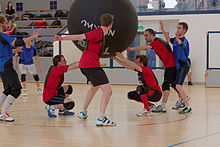Kin Ball
Kin-Ball is a cooperative team game and is played with three teams of four players each.
history
The game was invented in 1986 in Québec by the sports teacher Mario Demers. The game is played as a popular sport and competitive sport in many countries, it is particularly popular in Canada, Japan, Korea, France, Belgium and Switzerland. National associations belonging to the international association have been organized in 17 countries. Further associations are being set up.
Ball and team
The Kin Ball is 1.22 meters in diameter and weighs less than 1 kilogram. Due to its special flight characteristics, it demands coordination , strength, speed and endurance from the players. A color is assigned to each team. Usually the official colors are black, gray and blue. In some countries, e.g. E.g. Japan, other colors are also used (e.g. pink). To make a move, the attacking team, that is, the team in possession of the ball, must first designate a defending team. This is done by saying the word "Omnikin", followed by a color of the other two teams. After designation, the ball must be hit with a part of the body above the hip. If the defending team cannot control the ball before it hits the ground or an object outside the field of play, the other two teams get a point. After the ball has been brought under control, a new play can be started. The formerly defending team is now the attacker.
The way how long and for how many sets is played differs depending on the tournament and mode. At world and European championships, 13 points per set and 3 sets won are played. What is special, however, is that as soon as the first team has reached 11 points, the team with the weakest points has to leave the field and the rest of the set is played with only two teams. Another common mode is the playing time of 7 minutes per set (used at the 2014 Club Championships in Hradec Králové ). The clock is stopped in the last minute every time the game is interrupted, otherwise it continues to run even during an interruption, with the exception of time-outs. Another mode was tried out in the club categories as part of the 2019 World Cup in France. The teams play 4 sets up to 11 points, with a critical score of 9 points.
The playing area is rectangular, ideally square. In official international competitions, the size is stipulated to be 20 × 20 meters, which is the maximum permitted size. In the official regulations, minimum sizes are recommended for national and regional competitions, but these are not binding and can be changed by the organizer. The outer line must be monochrome and at least 5 centimeters wide. It is part of the playing field.
World championships
The first world championship took place in 2001 in Quebec, Canada . Since then, they have agreed on a two-year mode for women's and men's teams.
Men
| year | city |
|
|
|
|---|---|---|---|---|
| 2001 |
|
|
|
|
| 2002 |
|
|
|
|
| 2005 |
|
|
|
|
| 2007 |
|
|
|
|
| 2009 |
|
|
|
|
| 2011 |
|
|
|
|
| 2013 |
|
|
|
|
| 2015 |
|
|
|
Women
| year | city |
|
|
|
|---|---|---|---|---|
| 2001 |
|
|
|
|
| 2002 |
|
|
|
|
| 2005 |
|
|
|
|
| 2007 |
|
|
|
|
| 2009 |
|
|
|
|
| 2011 |
|
|
|
|
| 2013 |
|
|
|
|
| 2015 |
|
|
|
Web links
Individual evidence
- ↑ Federations - FIKB / IKBF. In: www.kin-ball.com. Retrieved June 1, 2016 .
